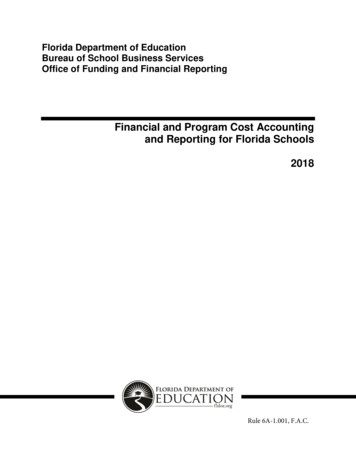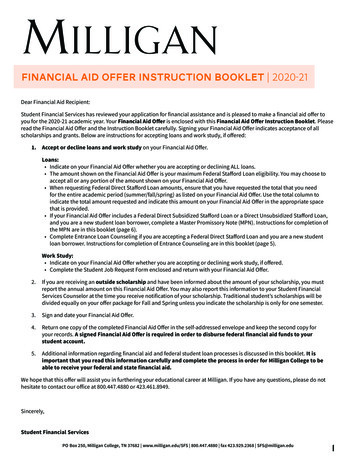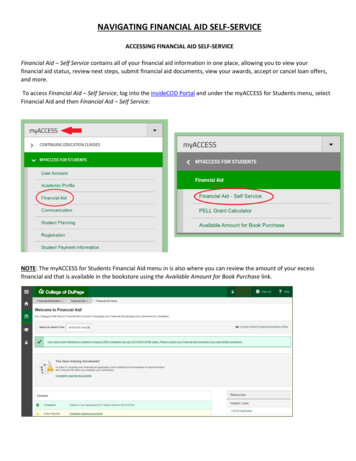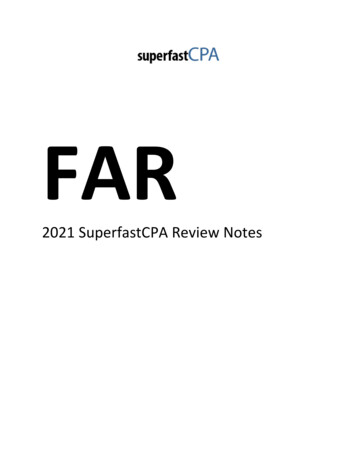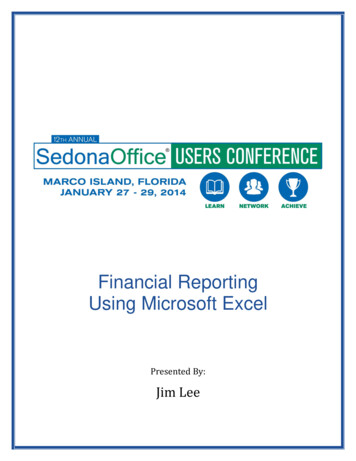
Transcription
Practice AidAccounting and Financial ReportingGuidelines for Cash- and Tax-BasisFinancial StatementsPA Cover Series.indd 25/17/18 3:03 PM
This document was created by the Association of International Certified Professional Accountants as a free memberbenefit which may be freely used and shared by members for personal use. All copyright statements should bemaintained. 2018 Association of International Certified Professional Accountants. All rights reserved.For other uses of this work, please email copyright@aicpa.org with your request or write to us at 220 Leigh FarmRoad, Durham, NC 27707-8110 USA.PA-CBT-Front Matter.indd 29/21/15 3:42 PM
PrefaceBecause of the complexities of accounting principles generally accepted in the United States of America (GAAP),many smaller entities have determined that financial statements prepared by applying the cash‐ or tax‐basis ofaccounting more appropriately suit their needs. Unlike GAAP, little authoritative guidance is available with re‐spect to the preparation of financial statements when applying the cash‐ or tax‐basis of accounting. Financialstatements prepared when applying the cash‐ or tax‐basis of accounting need to have a level of consistency sothat they are useful and not misleading to users of the financial statements. Additionally, because financialstatements prepared when applying the cash‐ or tax‐basis of accounting are not considered appropriate in formunless the financial statements include informative disclosures similar to those required by GAAP if the financialstatements contain items that are the same as, or similar to, those in financial statements prepared in accord‐ance with GAAP, preparers of full disclosure financial statements prepared when applying the cash‐ or tax‐basisof accounting are often faced with difficult questions.This practice aid is intended to provide preparers of cash‐ and tax‐basis financial statements with guidelines andbest practices to promote consistency and for resolving the often difficult questions regarding the preparationof such financial statements. Although this practice aid is the best source for such guidance, it is nonauthorita‐tive and should not be used as a substitute for the preparer’s professional judgment. This practice aid has notbeen approved, disapproved, or otherwise acted upon by any senior committee of the AICPA.This practice aid does not contain guidance with respect to performing an audit, review, or compilation of finan‐cial statements prepared when applying the cash‐ or tax‐basis of accounting. Practitioners engaged to audit suchfinancial statements should refer to Statements on Auditing Standards, including AU‐C section 800, Special Con‐siderations—Audits of Financial Statements Prepared in Accordance With Special Purpose Frameworks (AICPA,Professional Standards). Practitioners engaged to perform a review or compilation should refer to Statementson Standards for Accounting and Review Services (SSARSs). Likewise, CPAs in public practice who prepare finan‐cial statements for clients but are not engaged to perform an audit, review, or compilation of such financialstatements should refer to SSARSs.Prepared by Michael P. GlynnSenior Technical ManagerAudit and Attest Standards TeamEdited by Kelly G. McAuliffeTechnical ManagerMember Learning and Competency 2018 Association of International Certified Professional Accountants. All rights reserved.1
AcknowledgmentsIn 1998, the AICPA published the Practice Aid Preparing and Reporting on Cash‐ and Tax‐Basis Financial State‐ments. That publication was written by Michael J. Ramos, CPA, and edited by the AICPA Accounting and Publica‐tions Team. That publication served as a basis for the preparation of the original edition of this practice aid.In addition to this practice aid, the AICPA has also published a separate practice aid, Applying OCBOA in Stateand Local Government Financial Statements, authored by Michael A. (Mike) Crawford, CPA. Mike served as aninvaluable resource in the preparation of the original edition of this practice aid.The AICPA also greatly appreciates the invaluable input provided by the late Dr. Thomas A. Ratcliffe in the de‐velopment of the previous edition of this practice aid.Finally, the AICPA would like to thank the 2011/12 members of the Accounting and Review Services Committeeand the 2011/12 members of the AICPA PCPS Technical Issues Committee, who provided invaluable input re‐garding the content of the original edition of this practice aid.2 2018 Association of International Certified Professional Accountants. All rights reserved.
2018 Association of International Certified Professional Accountants. All rights reserved.3
Chapter 1Overview of Cash‐ and Tax‐Basis Financial StatementsIntroductionFinancial statements, including related notes, are a structured representation of historical financial informationintended to communicate an entity’s economic resources and obligations at a point in time or the changestherein for a period of time in accordance with a financial reporting framework. fn 1 All financial statements areprepared in accordance with a financial reporting framework. The term financial reporting framework is definedas “a set of criteria used to determine measurement, recognition, presentation, and disclosure of all materialitems appearing in the financial statements.” fn 2 Examples of financial reporting frameworks are accountingprinciples generally accepted in the United States of America (GAAP), International Financial Reporting Stand‐ards promulgated by the International Accounting Standards Board, and special purpose frameworks such as thecash‐, tax, regulatory‐, contractual‐, and other bases that use a definitive set of logical, reasonable criteria that isapplied to all material items appearing in the financial statements. The cash‐, tax‐, regulatory‐, and other‐basisof accounting are commonly referred to as other comprehensive bases of accounting.As GAAP becomes increasingly complex and less cost beneficial for private companies, such companies considerissuing cash‐ and tax‐basis financial statements as cost‐effective and useful alternatives. Many of these privatecompanies are small and medium‐sized entities that report to a narrow range of financial statement users.Those users, unlike users of public company financial statements, typically have access to company managementand additional financial information beyond that provided in the financial statements.Cash‐ or tax‐basis financial statements may be appropriate whenever the entity is not contractually or otherwiserequired to issue GAAP financial statements. The following conditions may indicate that financial statementsprepared when applying the cash‐ or tax‐basis of accounting is appropriate: The users of the financial statements—both internal and external to the entity—understand a cash‐ ortax‐basis presentation and find it relevant for their needs. It is cost‐effective to prepare cash‐ or tax‐basis financial statements. The operations of the entity are conducive to a cash‐ or tax‐basis presentation.Preparing cash‐ or tax‐basis financial statements has many benefits. A significant benefit is due to the fact thatmany smaller entities maintain their accounting records on a cash‐ or tax‐basis. Often, accounting and financepersonnel responsible for maintaining the books and records can more easily understand the concepts of cash infn 1Paragraph .05 of AR‐C section 90, Review of Financial Statements (AICPA, Professional Standards), and paragraph .13 of AU‐Csection 200, Overall Objectives of the Independent Auditor and Conduct of an Audit in Accordance With Generally Accepted AuditingStandards (AICPA, Professional Standards).fn 24See footnote 1. 2018 Association of International Certified Professional Accountants. All rights reserved.
and out as well as tax reporting compared to GAAP. Because the internal records are often maintained on thecash‐ or tax‐basis of accounting, it is easier to prepare the financial statements when applying that same basis. Ifthe financial statements are prepared in accordance with GAAP, the accounting and finance personnel would“true‐up” the financial information through a series of journal entries. Additionally, many users of smaller entityfinancial statements find cash‐ or tax‐basis financial statements to be more understandable than financialstatements prepared in accordance with GAAP because those users are often accustomed to preparing and con‐sidering budgets on a cash‐basis and understand tax issues.Because many smaller entities are appropriately concerned with minimizing costs and maximizing the resourcesthat are available to fund the operations of the business, resources allocated to accounting and financial report‐ing are often not sufficient to maintain GAAP basis accounting records and to prepare financial statements in ac‐cordance with GAAP. Preparing financial statements when applying the cash‐ or tax‐basis of accounting general‐ly is less costly than preparing GAAP financial statements because of the following: Less complex measurement requirements. Financial statements prepared when applying the cash‐basisof accounting reflect transactions resulting from cash receipt and disbursement transactions or events.Financial statements prepared when applying the tax‐basis of accounting reflect transactions in thesame manner as those transactions are reflected in the entity’s tax return. Less extensive disclosure requirements. Financial statements prepared when applying the cash‐ or tax‐basis of accounting do not require all of the extensive disclosures required of GAAP statements becausethe statements do not include some of the items, events, and transactions that are typically included inGAAP basis financial statements.Observations and SuggestionsOften, preparers of cash‐ and tax‐basis financial statements elect to omit substantially all disclosures required bythe cash‐ or tax‐basis of accounting. The omission of disclosures is a departure from the cash‐ or tax‐basis of ac‐counting and, if such disclosures were included in the financial statements, they might influence the user’s con‐clusions about the entity’s financial position, results of operations, and cash flows. However, the omission maynot necessarily result in misleading financial statements provided that the intended users are informed aboutsuch matters. Ability to prepare tax returns and financial statements from the same information. When tax‐basis finan‐cial statements are issued, a significant portion of the cost can be absorbed by the preparation of the taxreturn. Additionally, the entity is not required to maintain two sets of accounting records to account foritems such as depreciation, bad debts, and consolidation matters.However, in addition to the benefits of financial statements prepared when applying a cash‐ or tax‐basis of ac‐counting, financial statement preparers should also be aware of the limitations of such financial statements. Forexample, financial statements prepared when applying the cash‐ or tax‐basis of accounting may not meet theneeds of certain users such as regulators and certain lenders. In addition, the cash‐basis of accounting can beeasily manipulated by accelerating or delaying the timing of the receipt or disbursement of cash and thereforemay not be a comprehensive measure of the entity’s complete economic condition.In practice, the most typical industries in which cash‐ or tax‐basis financial statements are issued include the fol‐lowing: Professional services 2018 Association of International Certified Professional Accountants. All rights reserved.5
Medical Retail Real estate Farming/agricultural Construction Not‐for‐profitCash‐Basis of AccountingThe cash‐basis of accounting is a basis of accounting that the entity uses to record cash receipts and disburse‐ments. When applying the cash‐basis of accounting, transactions are recognized based on the timing of cash re‐ceipts and disbursements. As a result, revenues are recognized only when cash is received rather than when earned, and expenses are recognized only when cash is paid rather than when the obligation is incurred.When applying the cash‐basis, cash outflows to purchase an “asset” are not capitalized but instead are recordedas a disbursement as of the date of purchase, so there is no depreciation or amortization. Accruals are not madeand prepaid assets are not recorded.The cash‐basis of accounting in its purest form is rarely used but may be appropriate whenever the entity is interested primarily in sources and uses of cash. has a limited number of financial statement users. has relatively simple operations engaged in one primary activity. does not have significant amounts of debt, capital assets, or other items that would be recognized in ac‐cordance with the accrual basis.Examples of some entities that may use the cash‐basis of accounting include the following:6 Estates Trusts Civic ventures Student activity funds Political campaigns and committees 2018 Association of International Certified Professional Accountants. All rights reserved.
When applying the cash‐basis of accounting, because the only assets of the entity would be cash and cashequivalents and there would be no liabilities, a balance sheet equivalent is often not presented. The incomestatement equivalent would report cash receipts and disbursements and other changes in cash and cash equiva‐lents and disclose any restrictions on ending cash and cash equivalents.Any departure from the presentation of cash and cash equivalent balances and changes in such balances, suchas the reporting of long‐term debt arising from cash transactions, the capitalization and depreciation of capitalassets acquired with cash, or the reporting of investments or receivables and payables resulting from cashtransactions, should be considered a modification to the cash‐basis of accounting. Such deviations require eval‐uation regarding whether they are appropriate modifications of the cash‐basis of accounting. Appropriate modi‐fications of the cash‐basis of accounting are discussed in the subsequent section.In‐Substance Two‐Step Transactions or Events in the Cash‐Basis of AccountingThe preparer of cash‐basis financial statements may encounter single‐step transactions or events that may notdirectly involve a cash inflow or outflow but may nevertheless be recorded as an in‐substance two‐step cashtransaction or event when applying the cash‐basis of accounting. For example, management of an entity maysign a note from a bank in order to purchase equipment. The bank may then directly pay the vendor for the pur‐chase of the equipment. Because there was no cash transaction, the entity may not record the single‐step trans‐action in the financial statements. However, so as not to be misleading to users of the financial statements, thepreparer may choose to record the transaction as an in‐substance two‐step transaction. In accordance with thattreatment, the journal entries may look as follows:CashXX,XXXNote Proceeds (Revenue)XX,XXX(To record note proceeds that were paid directly to the vendor)Capital expenditureXX,XXXCashXX,XXX(To record purchase of equipment)Then, subsequent payments on the note would be recorded as follows:Debt service expenditure XXXCashXXX(To record principal and interest payment on note payable)Modified Cash‐Basis of AccountingThe modified cash‐basis of accounting involves logical and consistent modifications to transactions or eventsthat are derived from cash receipts or cash disbursements. For example, a modification to the cash‐basis of ac‐counting to report capital assets should involve recording and depreciating only those capital assets that resultfrom cash transactions or events. The modification should not involve the recording and depreciating of donatedcapital assets because these transactions or events do not involve an inflow or outflow of cash. Once deprecia‐ble capital assets arising from cash transactions or events are recorded when applying a modified cash‐basis ofaccounting, such assets should also be depreciated over their estimated useful lives. Depreciating capital assetsthat were acquired with cash is a logical allocation of the cash‐basis assets’ costs over the assets’ useful lives. 2018 Association of International Certified Professional Accountants. All rights reserved.7
An easy way to look at whether a modification is appropriate is to consider whether the transaction or eventwould have been recorded if the entity was preparing the cash‐basis financial statements. For example, if an en‐tity purchased a capital asset and was preparing cash‐basis financial statements, the journal entry would looklike this:Capital expenditureXXXXCash(To record purchase of capital asset)XXXXBecause cash is part of the journal entry, it would be an appropriate modification to capitalize the asset and de‐preciate the cost over the estimated useful life of the asset.On the other hand, the recording of trade accounts receivable arising from services provided or goods soldwould not be an appropriate modification of the cash‐basis of accounting assuming cash was not received at thetime the services were provided or goods were sold.Modifications to the cash‐basis of accounting generally result when cash receipts or cash disbursements providea benefit or an obligation that covers multiple reporting periods. For example, a preparer may conclude that fi‐nancial statement users would be misled if cash purchases of capital assets are recorded as disbursements orexpenditures in the period in which the assets are purchased. Instead, the preparer may elect to modify thecash‐basis of accounting to record the asset on the balance sheet equivalent and depreciate it over the estimat‐ed useful life of the asset, thereby, in effect, spreading the benefit of the cash outflow over multiple reportingperiods in a manner that has substantial support and is logical and consistent.Questions often arise in the application of a modified cash‐basis of accounting regarding whether reported as‐sets and liabilities derived from cash transactions or events should ever be written down or written off oncethey are recorded at their original cash value. Temporary changes in the fair value of an asset or liability shouldnot be recognized in applying a modified cash‐basis of accounting and all recognized assets and liabilities shouldbe measured and reported at their original cash value (net of any accumulated depreciation or amortization, ifapplicable). If an asset or liability has been permanently impaired and has no future cash value or represents nofuture obligation against cash, it would be appropriate to write‐down or write‐off such amounts in modifiedcash‐basis financial statements.A significant challenge to preparing financial statements when applying a modified cash‐basis of accounting isdeveloping the appropriate accounting policy that results in financial statements that meet the needs of theprimary users of the statements and consistently applying that policy to cash transactions and events in order tokeep the financial statements from being misleading for the purposes for which they are intended. The preparermay find benefit in spelling out the logic behind the cash‐basis modifications and documenting the accountingpolicy prior to preparation of the basic financial statements.Although there is no single accepted method of applying a modified cash‐basis of accounting, modified cash‐basis financial statements can be more meaningful if they are comparable with similar financial statements.Some preparers have inappropriately considered the modified cash‐basis of accounting as a “free‐for‐all” propo‐sition in which they can unilaterally and arbitrarily choose the modifications that they will apply. For example, apreparer may inappropriately decide to prepare financial statements applying a modified cash‐basis of account‐ing that records assets arising from cash transactions or events, including investments, inventories, and capitalassets but does not record short‐term and long‐term liabilities and other obligations arising from cash transac‐tions. Inconsistent uses of a modified cash‐basis framework should be avoided in general use financial state‐ments because such inconsistencies will normally result in financial statements that are misleading for general8 2018 Association of International Certified Professional Accountants. All rights reserved.
use. Financial statements that are prepared using inconsistent modifications may be appropriate for special pur‐poses involving limited users but should be labeled as such with clear disclosure and use of descriptive headings.With the needs of the primary financial statement users in mind, when preparing financial statements applying amodified cash‐basis of accounting, the preparer should consider modifying the following cash transactions orevents, among others, by the recording of the following: Receivables resulting from an outflow of cash, such as a cash advance to an employee Investments in marketable securities acquired with cash Inventories acquired with cash Capital assets arising from cash transactions and depreciating the assets where appropriate Deferred revenue resulting from cash receipts Liabilities resulting from short‐term cash borrowings Long‐term notes and other debt arising from cash transactions or events Any other material assets, liabilities, revenues, and expenses resulting from cash transactions or eventsIf the financial statements are prepared when applying a modified cash‐basis accounting policy in which one ormore of the preceding—but not all—are recorded, the preparer should be prepared to defend how the decisionto modify or not modify is a logical and consistent application of the accounting policy and does not result inmisleading financial statements for the purposes for which they are intended.A number of transactions or events are not appropriate modifications to the cash‐basis of accounting. Generally,these transactions or events should not be recorded when applying a modified cash‐basis of accounting becausethey do not involve cash inflows or outflows, are illogical, or are not substantially supported in the accountingliterature. Common transactions or events that should not be reported in financial statements prepared whenapplying a modified cash‐basis of accounting include the recording or adjusting of the following: Capital assets arising from cash transactions or events, but not recording depreciation where appropri‐ate Donated capital assets where cash outflows were not involved Accounts receivable from services provided or goods sold and other accrued receivables Pledges receivable or other receivables where cash outflows were not involved Investments for which cash outflows were not involved Accounts payable for goods or services received where no cash outflow was involved Accrued income taxes, accrued interest expense, other accrued liabilities where no cash outflow was in‐volved 2018 Association of International Certified Professional Accountants. All rights reserved.9
Subsequent write ups or write downs to fair value to recognize unrealized gains and losses on marketa‐ble investments Derivative instruments where cash inflows or outflows were not involved as well as the mark to marketfor fair value changesBecause modified cash‐basis frameworks do not involve financial statement elements resulting from accrualsand noncash transactions or events, it is unlikely that an acceptable modified cash‐basis framework would everbe materially equivalent to GAAP. However, it is important for financial statement preparers to avoid attemptingto make certain modifications to GAAP financial statements and then referring to those financial statements asmodified cash‐basis financial statements. For example, financial statements that are presented in conformitywith GAAP, except that material leases are not capitalized, are not considered modified cash‐basis financialstatements. Such financial statements are considered GAAP financial statements with a material departure dueto the failure to capitalize material leases. The preparer will need to use judgment in determining if modified“cash‐basis” statements are tantamount to financial statements purported to be prepared in accordance withGAAP with material departures therefrom.Tax‐Basis of AccountingThe tax‐basis is a basis of accounting that the entity uses to file its federal income tax or federal information re‐turn for the period covered by the financial statements.The tax‐basis of accounting is based on the principles and rules for accounting for transactions under the federalincome tax laws and regulations. Few new measurement guidelines need to be established because the methodis based on tax laws. The tax‐basis of accounting covers a range of alternative bases, from cash to full accrual,depending on the nature of the taxpayer, and in some circumstances, the taxpayer’s elections.An entity need not be a taxable entity to prepare tax‐basis financial statements. Any entity that files a returnwith the IRS, either an income tax return or an information return, may prepare tax‐basis financial statements.Therefore, not‐for‐profit organizations, C corporations, S corporations, partnerships, limited liability partner‐ships, limited liability companies, and sole proprietors may all use the tax‐basis of accounting.The tax‐basis of accounting is most useful for small, nonpublic entities whose financial statement users are in‐terested primarily in the tax aspects of their relationship with the entity. For example, investors in tax‐drivenpartnerships, such as those commonly employed in the real estate industry, may be primarily interested in thetax consequences of transactions. However, they may want more information than would be provided by a taxreturn.Determining Whether to Prepare and Issue Cash‐ or Tax‐Basis Financial StatementsAs long as the entity is not contractually or otherwise required to issue financial statements prepared in accord‐ance with GAAP or a regulatory or contractual basis of accounting, the entity may prepare and issue cash‐ or tax‐basis financial statements. Understanding the needs of the financial statement users is an important step in de‐termining whether to prepare and issue cash‐ or tax‐basis financial statements. If the users of the financialstatements understand the presentation, and if the information presented when applying that basis of account‐ing is relevant to their needs, then the preparer may determine that it is useful and appropriate to prepare andissue cash‐ or tax‐basis financial statements. The following are characteristics of entities that generally are goodcandidates to prepare cash‐ or tax‐basis financial statements:10 2018 Association of International Certified Professional Accountants. All rights reserved.
a. The entity’s creditors do not need or require financial statements prepared in accordance with GAAP.b. The cost of complying with GAAP would exceed the benefits (for example, a small construction contrac‐tor who would be required to account for long term contracts using the percentage of completionmethod and would be required to compute deferred taxes).c. The owners are closely involved in the day‐to‐day operations of the business and have a fairly accuratepicture of the entity’s financial position.d. The owners are primarily interested in cash flows (for example, a professional corporation of physiciansthat distributes its cash‐basis earnings through salaries, bonuses, and retirement plan contributions).e. The owners are primarily interested in the tax implications of transactions (for example, partners in apartnership who are concerned about the effects of transactions on their personal tax returns).f.It may not be appropriate to prepare and issue cash‐ or tax‐basis financial statements if the entity is orsoon will be required to issue GAAP‐basis financial statements. For example, management of a companythat is anticipating selling its business may be required to issue financial statements prepared in accord‐ance with GAAP.Additionally, financial statements prepared when applying the cash‐ or tax‐basis of accounting should not be is‐sued if the results are misleading. Cash‐ and tax‐basis financial statements are intended to be a cost‐effective al‐ternative to GAAP, not a way to deliberately mislead financial statement users.ExampleSituation In Which it May Not Be Prudent to Issue Tax‐Basis Financial Statements Long Street Partners has typically issued tax‐basis financial statements because the partners are moreinterested in the tax treatment of partnership transactions. Outside creditors have also accepted thetax‐basis financial statements as suitable for their needs. During the current year, two events occur thatsignificantly affect the partnership: Several large customers experience financial difficulty and the part‐nership’s receivables from the customers are in danger of not being collected. If the financial statementswere prepared in accordance with GAAP, the partnership would be required to record a valuation al‐lowance and recognize a bad debt expense. Under the tax rules, the partnership uses the direct write‐offmethod, so a tax deduction may not be allowed in the current year. The partnership has acknowledged that it is obligated to perform an environmental remediation at oneof its sites. If the financial statements were prepared in accordance with GAAP, the partnership wouldbe required to recognize the liability and a loss. Although the entity may disclose the information in arisks and uncertainties note, under the tax rules, the deduction is not allowed until the amount is paidand therefore would not be included in the income statement equivalent. Prior to preparing and issuing tax‐basis financial statements, in determining whether the prop
cash‐ or tax‐basis of accounting, it is easier to prepare the financial statements when applying that same basis. If the financial statements are prepared in accordance with GAAP, the accounting and finance personnel would "true‐up" the financial information through a series of journal entries.


